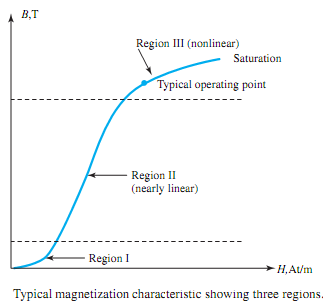Q. What is permeability of magnetic material?
For magnetic material media, the magnetic flux density B, expressed in tesla (T) or Wb/m2 , and the field intensity H, expressed in A/m or ampere-turns per meter (At/m), are related through the relationship
B = µH
where µ stands for the permeability of thematerial expressed in henrys permeter (H/m). The free- space permeability µ0 is a constant given by 4π × 10-7 H/m in the SI system of units. The same value holds good for air as well as for any nonmagnetic material. For a linear magnetic material which exhibits a straight-line relationship between B and H, the permeability is a constant given by the slope of the linear B-H characteristic, and it is related to the free-space permeability as
µ = µrµ0
where µr is the relative permeability, which is a dimensionless constant. If the B-H characteristic is nonlinear, as with a number of common magnetic materials, then the permeability varies as a function of the magnetic induction. The variation of B with H is depicted by the saturation curve of Figure, in which the slope of the curve clearly depends upon the operating flux density, as classified for convenience into regions I, II, and III.

There are severalmaterial classifications with their distinguishing characteristics. Ferromagnetic materials, for which µr >> 1, exhibit a high degree of magnetizability and are generally subdivided into hard and soft materials. Soft ferromagnetic materials include most of the steels and iron, whereas hard ferromagnetic materials include the permanent-magnet materials such as alnicos and alloys of cobalt with a rare-earth element such as samarium. Ferrimagnetic materials are ferrites composed of iron oxides, subdivided into hard and soft categories. Ferrofluids (magnetic fluids with iron-oxide particles suspended) and amorphous magnetic (soft ferromagnetic) materials were also developed later. Typical magnetic characteristics of some core materials are shown in Figure.